#Veda Moon
Explore tagged Tumblr posts
Text
Atmakaraka and Music 🎵🎶

This is sort of a fun post which I really really wanted to post and want to know how do you listen to your music and what's your Atmakaraka!
Let's start with Jupiter
Jupiter Atmakaraka
People who've Jupiter as Atmakaraka may listen to wide range of music be it japanese, Korean, classical,etc.. Jupiter is a planet of expansion according to Vedic astro and these people sometimes tend to listen to a music in a loop but not for a very long time.
Moon Atmakaraka
Moon is a fastest moving planet and also is connected to your emotions therefore these people tend to listen to music in shuffle and just want to change the music quickly. They also play sad song to feel the emotions strongly and cry while listening to the song.
Venus Atmakaraka
People having Venus as Atmakaraka repeats the song on loop of they like the song alot. They can play song for hours and not be irritated from it. They may like jazz songs, 🎷 songs all those luxurious songs which just shows the Venus in a person. Could also be in classical too.

What's your Atmakaraka and how do you listen to your music? Please comment I'm super curious!
Radhey Radhey 🪷🕊️
#astro community#astro notes#astro observations#astrology community#astrology observations#astrology readings#astrology signs#astrology#astrology blog#vedic chart#vedicmaths#vedic astro observations#vedic astrology#vedanta#vedic astro notes#hindu vedas#veddie#galaxy#universe worship#universe travel#cosmos#consciousness#eternal atman#atman#atmakaraka#soulmates#moon#venus#jupiter planet#jupiter speaks
286 notes
·
View notes
Text
"Who's Hotter?" Some Old School White-Haired Anime Men










#ayame sohma#fruits basket#rosiel#angel sanctuary#taishakuten#rg veda#sesshomaru#inuyasha#yue cardcaptor sakura#yue#cardcaptor sakura#kunzite#sailor moon#zechs merquise#gundam wing#innova#Magic Knight Rayearth#Kagato#tenchi muyo#sephiroth#final fantasy vii#schrodingers minor#anime#polls#anime poll#whoishotteranimepolls
87 notes
·
View notes
Text
YOU GUYS I AM ACTUALLY TWEAKING OUT SO HARD I FEEL NAUSEOUS /VVPOS IM GOING TO START SCFEAMING IM SHAKING
HIS VOICE HIS FUCKING VOICE OH MY GOD I LOVE HIM I LOVE HIM ITS SO PRETTY I WISH HE GOT TO USE IT MORE AS SEABURY OR ANYONE ELSE WHEN HES NOT UNDERSTUDYING SO BADLY I NEED HIM YALL I FEEL LIKE SCREAMING AND RUNNING AROUND MY ROOM
#IM GNAWING AT THE IRON BARS OF MY ENCLOSURE#I WANT TO SHOUT SO LOUD#RIPS OPEN SHIRT LIKE A WEREWOLF AT A FULL MOON#I FEEL SICK#MY EYES ARE WIDE#HHHHGGRRAAAGAHHHHHH#quiz time who’s my favorite actor (HARD)#shoutout to my friend veda (@anybodyhaveamap on yt) for recording it :33#thayne jasperson#hamilton#hamilton musical#I FEEL PHYSICALLY ILL
25 notes
·
View notes
Text
Athena, Alexa Bliss, Veda Scott 💋

23 notes
·
View notes
Text
Steam Next Fest October 2023
Alright let's see as many Demos as possible!
1. Ocelot Sunrise
A nice roguelite bullet hell with various levels (only one playable in the demo) and a sci fi scavengers story and a comics/borderlandesque aesthetic that makes the cutscenes very nice to look at. The background music is a bop too. Alas the controller controls are not completely implemented yet and quite clunky to use in a mixed way, however the power ups and the weapons seems really fun to play with.
7.5/10
Wishlisted

2. ASTRA: Knights of Veda
On first impact a bread and butter jrpg with all the pros and cons of the genre like huge bazongas! Regardless of which category you consider them in. The artstyle in game and in battle is expecially nice with this sort of "dress-up paper doll" look that sets it somewhat apart and the cutscene style for the evil faction and the dream realm is quite good. The controls are nice and intuitive enough although it needs a mouse to click on certain things like equipment. The voice acting is good enough? I'd say but the audio levels mixing leaves to be desired in some parts. Now the cons: it required to make an account even to play the demo and it has an obligatory post download 8 gb of additional content, there are "daily reward" and buyable cosmetics but most aggravating of all (for me) there are minutes of cutscenes every 5 minutes or so of gameplay.
5/10
Not for me

3. Estate Agent Simulator
The first bugged demo. The second prompt for the italian tutorial popped up with this half baked and definitely not italian way and had to restart the game in english
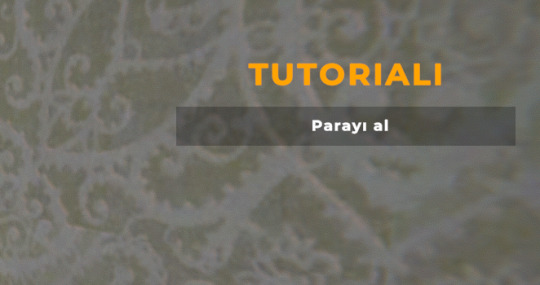
The gameplay itself is fine? For a game like this? Certainly not particularly nice nor particularly bad but the camera bobbing is atrocious, it gave me nausea after I cleaned the first house, the game was also completely silent. I'll add a +1 for the promise of a pettable dog
4/10

4. Lose CTRL
A surreal satirical you rage you lose puzzle game in which you play as Billy as he tries to climb the corporate ladder to reach a segway. The game mess with your controls and your mind in a mix between Get Over It and Brazil (1985). The split screen capabilities intrigue me although I wonder how it could work with keyboard and mouse controls. The general style is charming and distinctive but also amateurish and rough around the edges. To try, at least once.
7/10
Wishlisted

5. Leila
Leila is a chill and relaxing kinda lofi click and drag puzzle game that goes back the memory lane in a coming of age(?) Tale for a middle aged woman, the titular Leila. The puzzles shown have a nice variety between styles and difficulties, and they are certainly meant for someone looking to lubricate those neurons. The art and the background music are pretty nice and the voice acting is quite good too. If you like click and drag puzzles I feel that wishlisting this one (and always trying the demo before) maybe one of your best bets so far.
8/10

6. Tales from the Dancing Moon
An old-school-ish rpg inspired by runescape in which you run around doing errands for the townsfolk and at the same time try to unravel the mistery of your memory loss, the presence of a smartphone that you can use to take photos in game gives it a mild isekai flavour but not too strong based on what I've seen. The controls appear fluid enough and the sound design while not spectacular does it's job. The character creation menu is surprisingly in-depth for this kind of games.
6.5/10
Runescape wannabe
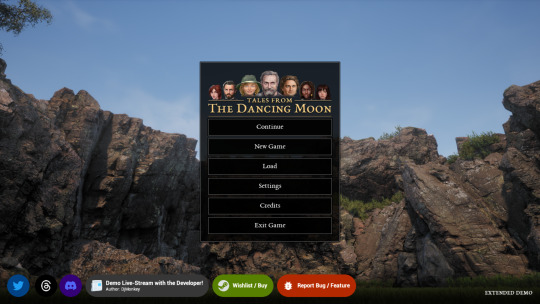
7. There's Always a Madman: Fight or Flight
A text based spy adventure in which you play as this super special agent and have to choose between different options both in action and dialogue. While the story itself seems nice the absence of any voice action or any background image besides some solid background color makes the experience hoverwelmingly boring as you are left to click repeatedly thru text.
3/10
I yawned

8. Rocket!
A mix between a shoot them up and a roguelite bullet hell heavily inspired by galaga and the classics. While the concept is nice and seems intriguing enough and I don't doubt it may end up garnering quite the cult following like many other niche games the controls are exceedingly hard and finicky, the spaceship appear to drift incontrollably with no apparent rhyme or reason.
4/10

9. Aureole: Wings of Hope
An incredibly fun and novelty platformer/dasher game where you follow the tale of two angels while you speed and dash and jump at full force thru obstacles in the shape of a bouncy halo. The mechanics are surprisingly simple and incredibly flexible at the same time, creating a gameplay that can be adjusted to your own needs, I appreciated particularly the ability to "freeze" while you charge a jump or a dash. Despite not being a platformer lover I absolutely adored this little demo to bits, so far the only that has left me truly wanting more.
9/10
Wishlisted

#steam next fest#ocelot sunrise#ASTRA: knights of Veda#indie games#jrpg#roguelite#bullet hell#estate agent simulator#sim games#lose CTRL#indie puzzle game#leila#click and drag#rpg#old school rpg#tales from the dancing moon#there's always a madman: fight or flight#text based game#rocket!#shmup#aureole: wings of hope#platformer#metroidvania
3 notes
·
View notes
Text
I am debating whether to change Vedas' name to Six as a reference to Six Flag again because that amusement park was a huge part of my childhood, and also because I rode my first rollercoaster ever at the park.
But also, I think I will change Dawn and Dusk around and make the one here that says Dawn into her main color pallette.

#vedas♡#But heehee Maskky may have some powers relating to the night sky specifically like stars and the moon#So what if Vedas/Six had some sort or power to control the time of day when she's more experienced with magic :>
3 notes
·
View notes
Text

#esoteric#mystery schools#photon belt#spiritual initiation#theology#spiritual awakening#spiritual journey#self love#higher self#alchemy#lord shiva#hindu vedas#higher frequency#spirituality#spiritual direction#moon#symbols
0 notes
Text
I replaced Yasha and Ashura with Sailor Cosmos and Mamoru.
0 notes
Text
the beauty of shravana is so ethereal. absolutely divine. in the vedas it is said that the goddess laxmi resides in this nakshatra, hence her husband, lord vishnu, is the presiding deity.


janhvi kapoor, moon & jupiter in shravana

tyla — sun, venus & mercury in shravana
#shravana nakshatra#shravana#goddess lakshmi#vedic astrology#astro observations#nakshatra#capricorn#vishnu
184 notes
·
View notes
Text
↺ AUSPICIOUS PLACEMENTS TO HAVE IN NATAL CHART
basics of vedic astrology. ask box. pinned.
note: only applicable to vedic charts. apply to western charts at your own accord.

these are general placements and don't guarantee anything on their own. if you want to be a shitty person, then even mahabhagya yogas or mahapurusha yogas will yield negative results and bring bad luck and accompany a massive fall from fame.

mars / saturn in the 3rd house + house lord present in another house (not mandatory, but makes it better)
both mars and saturn are naturally malefic planets and naturally, harm the house they are sitting in. when these planets sit in the upchaya houses (3,6,11), then their immense malefic energy is converted into courage, valor, and strength. it is best when these planetss sit in the 3rd house, however. 3rd house is the house of initiation. having mars in this house increases the quality of leadership in the native. it makes them especially brave and gives them the opportunity to master the negative side of their mars and make it even more auspicious. even having a maraka mars is good in this house because it will repeatedly put you in positions where you are made to realize and accept your negative qualities, and also rewarded for mastering them. saturn in 3rd house disciplines the fluttery, airy nature associated with this house. of course, curiosity is still pretty much the trademark of any 3rd house placement, but saturn here disciplines one's efforts towards learning in younger years and taking initiative when older. in particular, it bestows the power of impressive speech that is enough to make heads turn.
benefic planets in the 1st, 2nd, 5th, 9th, 11th / laxmi houses or laxmi yoga
in the horoscope, if the 1st lord, 2nd lord, and 11th lord are situated in self-owned sign, then the person will be rich. if the mutual zodiac sign exchange of the 2nd and 11th lord is happening or 11th lord is in 11th house, then one attains lakshmi. if the lagnesh is located in 2nd house and 2nd lord is in the 11th house or 11th lord in the second house of the horoscope, then lakshmi yoga is formed. in the horoscope, if the moon is located in an auspicious zodiac along with venus but not in the sixth house then good wealth is attained. this is really a very lucky placement imo. goddess lakshmi personally gives her blessings to these people, and for hindus, it is highly recommended to pray to goddess lakshmi with a genuine, clear heart and revere her as a mother. however, do be cautious that you also pray to shri vishnu because goddess lakshmi rides an owl, and owls on their own bring darkness. when goddess lakshmi comes into ones life with shri vishnu, they come on the king of the birds, garuda and spread light and divinity into one's life.
the mahapurusha yogas
having any of the mahapurusha yogas is literally a lottery ticket placement lmao. the planet forming the yoga immediately becomes one of the dominant planets of your personality and it is especially pronounced if the yoga is formed in the 1st-7th house axis. for ex. i have hamsa yoga in 7th house and a mars ak; i also have a younger brother. in his chart's 11th house, he has jupiter and mars. hence, despite having no jupiter dominance otherwise, jupiter becomes one of my dominant planets. i also have pronounced physical features that are associated with a hamsa yoga because jupiter is aspecting the ascendant and hence heavily influences my looks.
i. hamsa yoga — jupiter
when jupiter in cancer / pisces / sagittarius is present in any of the kendra houses. preferably but not mandatorily, without conjunctions with any other planet and not retrograde.
to quote the brihat parashara hora shastra:
the native with hamsa (swan, in hindi) yoga has a virtuous personality and is learned in the vedas. the hamsa native has voice like a swan, has a handsome appearance and well developed nose. they are a king with phlegmatic temperament, honey like tawny coloured eyes, red, coloured nails, sharp intelligence, sturdy cheeks, round, forehead and beautiful feet. they have marks of matsya (fish), ankush (the iron hook with which elephants are driven), dhanusha (bow), shankh (conch), kamal (lotus) in their hands and feet. they are very passionate and their lust remains unfulfilled. they are fond of swimming and playing games in watery places. they enjoy life fully and live as affluent, influential people and attain the pleasure of proper burial / cremation of their body after their death. they are most likely to own fertile lands near river beds, like near the ganga and yamuna.
one highlightable feature here is that these people have very beautifully formed feet; starting narrow and turning slightly broad by the tips with inwardly shaped toes that are often long and with shiny, clean pinkish nails. their feet are naturally warm but have a tendency quickly becoming cold and have light pink soles. such feet are highly auspicious and regardless of any yoga, are indicative of a good jupiter.
ii. malavya yoga — venus
when venus in taurus / libra / pisces is present in any of the kendra houses. preferably but not mandatorily, without conjunctions with any other planet and not retrograde, again, preferably.
to quote the brihat parashara hora shastra:
the malavya native has beautiful lips and a slender waist. they are lustrous like the moon and have fragrance in their body. they are of ordinary red complexion, have a medium stature and clean and beautiful teeth. their voice is like that of an elephant and their arms are long enough to reach upto his knees. they live happily for as owner of lands such as sindhu and malwa and then leaves for the heavenly abode.
iii. ruchaka yoga — mars
when mars in aries / scorpio/ capricorn is present in any of the kendra houses. preferably but not mandatorily, without conjunctions with any other planet and not retrograde, again, preferably.
to quote the brihat parashara hora shastra:
the ruchaka native possesses a long face, he is very enthusiastic, has spotless lustre, is powerful, has attractive brows, black hair and is fond of all things. they love to fight wars, are victorious over enemies, are discriminative, are protector of thieves and has cruel temperament and slender thighs. they are a devotee of brahmins, have marks of veena (musical instrument of goddess saraswati), dhanusha (bow), pasha(pāśa, often translated as "noose" or "lasso", is a supernatural weapon depicted in hindu iconography. hindu deities such as ganesha, yama, shyamala devi and varuna are depicted with the pasha in their hands.) and vrasha (unsure what this means, typically refers to a division of earth separated by mountain ranges but it doesn't make sense here; if anyone knows, please let me know as well) signs in their hands along with chakra rekha / line. they are well versed in occult sciences. they are tall, with a thin, slender waist and attractive physique.
these natives live an averagely long life and are most likely to be owner of lands of hilly regions or with red soils.
iv. bhadra yoga — mercury
when mercury in gemini / virgo is present in any of the kendra houses. preferably but not mandatorily, without conjunctions with any other planet and not retrograde, again, preferably.
to quote the brihat parashara hora shastra:
the bhadra native is splendorous like a lion, has very developed chest (or chest with well developed muscles), has the gait of an elephant, has long and thick arms, is learned in all respects. they are well versed in yoga performance, are of satwaguna qualities and have beautiful feet and a beautifully formed forehead. they are fond of luxuries and comforts and have marks of sankha (conch), chakra, gada, arrow, elephant, dhwaja (flag) and hala (plough) in their hands and feet. they are well versed in shastras, have black and curly hair, possess independent nature, and are a protector of their family. their friends share in the enjoyment of their wealth. they live happily with their wife and children and as the owners of Madhya Desha and enjoy a long life.
v. sasa yoga — saturn
when saturn in capricorn / aquarius / libra is present in any of the kendra houses. preferably but not mandatorily, without conjunctions with any other planet and not retrograde, again, preferably.
to quote the brihat parashara hora shastra:
the sasa native has small sized teeth and face but their body is not small. they are valorous. they have a slender waist and beautiful thighs. they are wise and enjoy wandering in forests and mountains. they are well versed in the loopholes (weaknesses) of the enemy. they are lively, virile and fond of women. they usurp other people’s wealth. they have marks of mala (garland), mridanga (musical instruments) and weapons in their hands and feet. they live averagely long lives and most often attain the higher lokas after death. in terms of land, there is no specification; they rule over lands that they desire.
sasa yoga gives enhanced results if venus is present with libra saturn, or is in good dignity, overall.
no malefics in the 2nd-8th house axis / 4th-10th house axis + benefic moon
this is pretty much a placement that indicates having a balanced and peaceful mental health. this is especially pronounced if only benefics are present in these axes or if they are entirely empty. it gives a good, stable childhood and responsible guardians / parents. it's not as flattering as many of the other placements here, but this is a favourable placement for your mental health. sudden death, spontaneity and sudden loss of wealth are prevented through this. of course, a lot of exceptions are applicable here, too. like rahu-ketu axis in the 1st-7th house or being born under a waning moon / new moon period which makes the moon a malefic and destroys inner peace. seriously though, having a weak moon is a curse because it hinders passion, creativity, self expression, focus and intelligence.
other forms of the mahapurusha yogas that are particularly lucky but i needn't elaborate:
venus / jupiter in 7th house in own sign / exalted sign: good for relationships and business exalted mars in 10th house: good for career and helps in cultivating drive. exalted jupiter in 1st house: a very likeable, pleasant, virtuous and amazing personality.
exalted /favourable ketu
a favourable ketu is less karmic baggage and favours the native's pursuit towards occult science. it also makes the native question society and the way it works; an exalted ketu puts its energy into attracting knowledge and spiritual elements into one's life. this for sure indicates a person with high moral values and good samskaar / 'behaviour', for lack of a better english equivalent. once again, this is not as flattering as the others, but it reduces the obstacles to be faced in life. a good ketu attracts peace into native's life.
mahabhagya 'highly fortunate' yoga
it is pretty rare since quite a few demands are to be met, but if you have it in your chart, then it means that you have collected a lot of good karma in your previous lives and will be blessed with all sorts of luxuries and guidance from divine energies in this life. for male natives, sun, moon and lagna must occupy odd signs and should be strong during the daytime. for female it should be vice versa to get the full power of this yoga. this yoga is applicable only when the sun, moon and lagna are not affected by malefics or are not malefics themselves. note that amavasya moon and waning moon are malefics. note that in vedic culture, day and night are defined via the sunrise and sunset time; so make sure that for male natives, you were born after sunrise, and for female natives, you were born after sunset and before next day's sunrise. the native is born into a good and affluent family and enjoys all sorts of comforts in their childhood. this yoga is literally all sunshine and daisies, it has no bad aspect. if you have it, then you will be blessed with all sorts of luxuries in life. the best things about it is that it blesses you with well-wishers in life so that you never go astray your life path. the divine is with you, and all pursuits become successful.

ॐ नमो भगवते वासुदेवाय नमः
#astro community#astro observations#astro notes#astrology#astrology observations#vedic astrology#astrology readings#astroblr#astrology notes#astrology blog#vedic chart#vedic astro notes#vedic astro observations#darakaraka#18+ astrology
266 notes
·
View notes
Text
Requested Rec List: Manga with Bisexual Main Characters


Making rec lists by a request is not our usual thing (though we’d love to make it more our thing! feel free to drop us an ask with a request), but we recently got an ask the-bi-library (@the-bi-library ) on Tumblr we could not refuse: “do you have any recommendations for mangas with bisexual main characters for me, please?” And boy, do we have some! Contributors to the list are Nina Waters, Rhosyn Goodfellow, and an anonymous contributor.
10 Dance by Inouesatoh
Blue Flag by Kaito
Given by Natsuki Kizu
Fake by Sanami Matoh
Rg Veda by CLAMP
xxxHolic by CLAMP
Until the Full Moon by Sanami Matoh
The Guy She Was Interested In Wasn’t A Guy At All by Sumiko Arai
Maybe Akira-kun, Maybe Akira-chan by Yasuko
My Next Life as a Villainess: All Routes Lead to Doom! by Satoru Yamaguchi & Nami Hidaka
Devilman by Go Nagai
Saiyuki by Kazuya Minekura
What manga with bisexual protagonists are your favorite?
Find these manga, and lots of other books with bisexual characters, on our bi-or-pan-characters shelf on Goodreads!
Do these sound fun? You can buy them through the Duck Prints Press Bookshop.org affiliate shop (though sadly, some are out of print currently).
Join our Book Lover’s Discord server to chat with us about YOUR favorite manga!
#duck prints press#manga#queer manga#bisexual#bisexual characters#rec list#book recs#book recommendations
59 notes
·
View notes
Text
Multiple Marriage 7th house Vedic Astrology

In Vedic Astrology when a chart have multiple planets in their 7th house which is more than 1 planet then it shows multiple marriage as it weakens the 7th house and destroy it's strength.

When your 7th house is a dual sign, then there are higher chances to have a second marriage or multiple marriage.
If the Lord of the 7th house has any relationship with Malefic Planets like Saturn, Rahu, Ketu.
Malefic Planets are placed in the 7th house.
multiple factors trigger the events such as favorable dashas and transits, the dignity of Lagna lord, 7th house, and 7th lord.
But you can definitely check some of these signs to check if you have any of these placements.

Radhey Radhey 🪷🪷
#astro community#astro notes#astro observations#astrology#astrology blog#astrology community#astrology observations#astrology readings#vedic chart#astrology signs#hindu vedas#vedic astro observations#vedic astrology#vedic astro notes#veddie#vedanta#spirituality#spiritual awakening#holy spirit#spiritual journey#spiritualgrowth#birth chart reading#reading#short reads#saturn#rahu ketu#moon#night sky#space#outer space
52 notes
·
View notes
Text
Shravana - The Power of Knowledge

Degrees: 10°00 Capricorn to 23°20 Capricorn Deities: Vishnu, the preserver of the cosmos; Sarasvati, Goddess of learning and wisdom. Vimshottari Lord: Moon Sounds: जू ju, जे je, जो jo, घा gha The core meaning: Shravana is the sign of the Vedas, the supreme knowledge revealed by God, the demigods and the sages. You are the recipient of a deep and ancient knowledge coming from your past lives. You listen, you absorb new information to improve what you already know. And you impart it through teaching, writing or giving advice. Languages and words have no secret for you. Keep in mind that this knowledge is a sacred blessing from God, do not disappoint the Heavens. Avoid the greedy, small-minded people, listen to your intuition and look up at the sky because this is where you belong. Qualities: charming, good listener, imaginative, intuitive, wise, communication skills, creative. Affliction: hypersensitive, gossiping, too talkative, too idealistic, slanderous, pessimistic. Interest in languages, communication, ancient knowledge, religion, history, astrology....
#astrology#vedic astrology#jyotish#nakshatras#sidereal astrology#astro#degree#degrees#astro community#astro notes#vedic astro notes#shravana#capricorn#shravana ascendant#shravana rising#shravana moon#shravana sun#shravana ak#shravana atmakaraka#shravana first lord
116 notes
·
View notes
Text
Flowing with Divinity : River Names of Sri Rukminī from Her Sahasranāma 🐚🫧


Gaṅgā (गङ्गा)
Gaṅgā, the celestial river, descends from the heavens, sanctifying all in her path. Rukmini, like Ganga, is a source of divine purity, bestowing grace upon her devotees.
Gaṅgāsāgaravāsagā (गङ्गासागरवासगा)
She who resides in the sacred confluence where the Gaṅgā meets the ocean, symbolizing the endless union of devotion and divinity.


Yamunā (यमुना)
The sacred river Yamuna, dark as a rain-filled cloud, is revered as the sister of Yama and the beloved companion of Śrī Krishna’s pastimes. Just as Yamuna’s waters witnessed the divine leelas of Krishna in Vrindavan, Rukmini, as the embodiment of devotion, carries the essence of unwavering love and surrender. Like Yamunā, who flows ceaselessly toward the ocean, Rukminī’s heart flows eternally toward Krishna, dissolving all barriers in the current of divine love. Just as the river’s waters grant spiritual liberation, Rukminī’s bhakti purifies the soul, drawing devotees into the embrace of the Supreme. She is inseparable from Krishna’s divine play, carrying the sweetness of devotion in her being, nourishing the world with her love, and leading seekers toward the eternal shores of Krishna’s embrace.


Sarasvatī (सरस्वती)
The Sarasvatī River, though often unseen, is revered as the sacred flow of wisdom, purity, and spiritual power. Emerging from the divine realms, it merges into the Triveṇī at Prayāga, signifying the confluence of knowledge, devotion, and righteousness. Just as Sarasvati remains hidden yet ever-present, Rukminī embodies the silent yet profound wisdom of divine love—her devotion to Krishna flowing like an eternal river, nourishing the soul beyond what the eyes can see. Like Sarasvatī, who nourishes the Vedas and purifies the mind, Rukminī’s words and actions reflect the highest truth—unwavering faith and surrender to the Supreme. She is the Saraswati of devotion, where knowledge transforms into love, and love into liberation, guiding seekers toward Krishna’s divine embrace.


Mandākinī (मन्दाकिनी)
Flowing through the divine forests of Chitrakuta, Mandākinī's waters sparkle like jewels, reflecting the purity of ascetics and sages. Just as Rukminī embodies the serene beauty of devotion, Mandakini enchants the heart with its divine presence. Lord Ram, addressing the moon-faced daughter of King Janaka; Sita, described the river Mandakini: "O Princess, behold the river with its enchanting banks, home to swans, cranes, and flowering trees, resembling the river Sangandhika of Kuvera’s realm. Its muddy fords, stirred by deer, attract the heart. Ascetics bathe here, and munis worship the sun with raised arms. The trees sway, making the hills dance, while scattered blossoms offer a floral tribute to the river. The waters sparkle like gems, forming a serene sandy beach." (Valmiki Ramayana)


Vipāśā (विपाशा)
Originating from the Himalayas, the river Vipasa symbolizes liberation—its name itself means "freedom from bondage." Rukminī, the consort of the Supreme, represents spiritual emancipation, guiding her devotees toward divine liberation.
﹋﹋﹋﹋﹋﹋﹋﹋﹋﹋﹋﹋﹋﹋﹋﹋﹋
Follow me on 🪼
~ ig
~ yt
~ pinterest
#shrikrishna#rukmini#krishna#rukminikrishna#krishnaconsciousness#desi aesthetic#hinduism#desi tumblr#krishnakrishna#apricitycanvas#dwarkadhish#dwarka#rukmanikrishna#rukminiconsciousness#rukmani#ganga#yamuna#saraswati
43 notes
·
View notes
Text
The Pleiades
Astronomy Facts
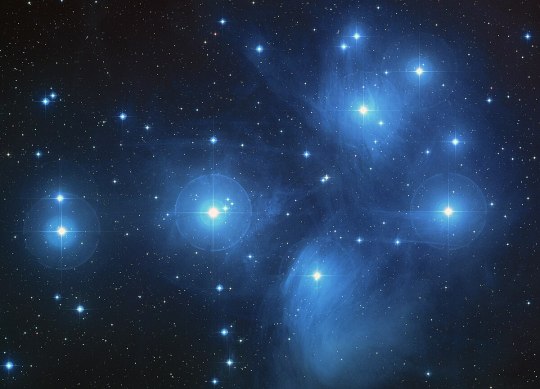
The Pleiades, also known as the Seven Sisters or Messier 45 (M45) is an asterism, or star group of an open star cluster containing young B-type stars that formed in the last 100 million years just above the shoulder of Taurus the bull constellation.
It's on average about 444 light years away from Earth. That means the light in this photo left the star cluster in 1581. It's also the nearest Messier object to Earth. It's the most obvious star cluster visible to the naked eye.
In Ancient Times
They were one of the first stars mentions in literature, appearing in Chinese Annuals in 2350bc. The Nebra sky disc found in Germany has these stars displayed with the Sun and Moon, this disc was made in the 1600BC. Sailors used them for navigation, as the “Plein” in their name literally means “To sail” in Ancient Greek. Farmers used them as a marker for when to sow and harvest crops, since they appear in the autumn, being a winter Asterism. The Zuni tribe of New Mexico called them “seed stars” and when the stars disappeared in the spring they sowed their crops. Other cultures believed they seeded the planet and were the seven mothers of Earth, (hey Hemidal of the Aesir in Norse Mythology had nine mothers).
In ancient times the Pleiades played a role in establishing many calendars.
In ancient India, in the Atharvaveda (the knowledge store house of Antharvanas, the procedures for everyday life, the fourth Veda and part of the Vedic scriptures of Hinduism) the Pleiades have the name Kttika, which meant the cuttings or those that mark the break of the year.
The Stories
The Pleiades are a very visible star cluster and because of that and because it's close to the ecliptic (the line of the sun's passage in the night sky or the zodiac line) and it's seasonal appearance makes it a great source of stories, folklore and myths.
Nearly all of them say they're 7 sisters and usually explain why they see 6 stars.
North Africa
The Tuareg Berbers, a semi nomadic ethnic group from North Africa (mainly the Sahara) call the Pleiades Cat ihed meaning Daughters of Night. Their proverb (translated into English) is: “When the Daughters of Night fall, I wake looking for my goatskin bag to drink. When they rise, I wake looking for cloth/clothes to wear”
This means that when the Pleiades sink below the horizon at spring, Summer is coming, and in the desert will be getting hot and drier, and they rise in the Autumn and that is when the rainy season starts, so start dressing warmer.
Native American
Wyoming- Kiowa tribe
In Wyoming, North America stands Mateo Tipi or Devil’s Tower. Legend is that one day the tribe was going south, and a bear attacked a group of seven girls. They climbed the rock and asked the Great Spirit for help. The Great Spirit made the rock grow taller and the bears kept clawing and scraping it away, so the rock grew taller still. Until the little girls were high in the sky and became stars.
Greek Myth
I'm ending on this one as it ties to a winter cconstellation. Also we often use the Greek names in astronomy.
The Pleiades in Greek mythology are daughters of Pleione and Oceanid and the Titan Atlas.
The sisters names are:
· Maia (mother/ nurse/ great one) who was the mother of Hermes
· Electra who was the mother of Dardanus and Iasion by Zeus
· Taygete mother of Laceaemon by Zeus
· Alcyone (ally) the mother of Hyrieus, Hyperenor, Aethusa, Hyperes, Anthas and Epopeus by Poseidon
· Celaeno mother of Lycus, Nycteus, Eurypylus and Euphemus by Poseidon
· Sterope (Asterope) (star) mother of King Oenomaus by Ares (some stories say she's Oenomaus wife)
· Merope the youngest who married Sisyphus.
Merope is the lost sister as her star is the last to have been mapped by Astronomers and is the faintest star, invisible to the naked eye. In the stories she's lost either because she married a mortal, or because she married Sisyphus who was punished in the underworld for both murdering his guests and repeatedly literally escaping from death . His punishment is to roll a stone up a hill forever. Either way Merope faded away. In other versions the lost sister is Electra, whose son was the King of Troy and she faded when Troy fell.
In one version of their story, the Pleiades were grief stricken at either their father Atlas who was punished after the Titan's war with the Olympians by being forced to hold up the heavens , or the fate of their sisters the Hyades and killed themselves. Zeus changed them into stars.
Another version that ties to the constellation of Orion is that after Atlas was imprisoned Orion began to relentlessly pursue the Pleiades. They were companions of Artemis who asked her father Zeus to protect them. Zeus changed them into doves then stars. Artemis was then angry that she lost her companions so her brother Apollo created a Scorpion that killed Orion. Orion then was changed into a constellation and so was the Scorpion (Scorpio) and Orion continues to pursue the Pleiades in the sky, and he in turn is chased off the sky by Scorpio.
50 notes
·
View notes
Text
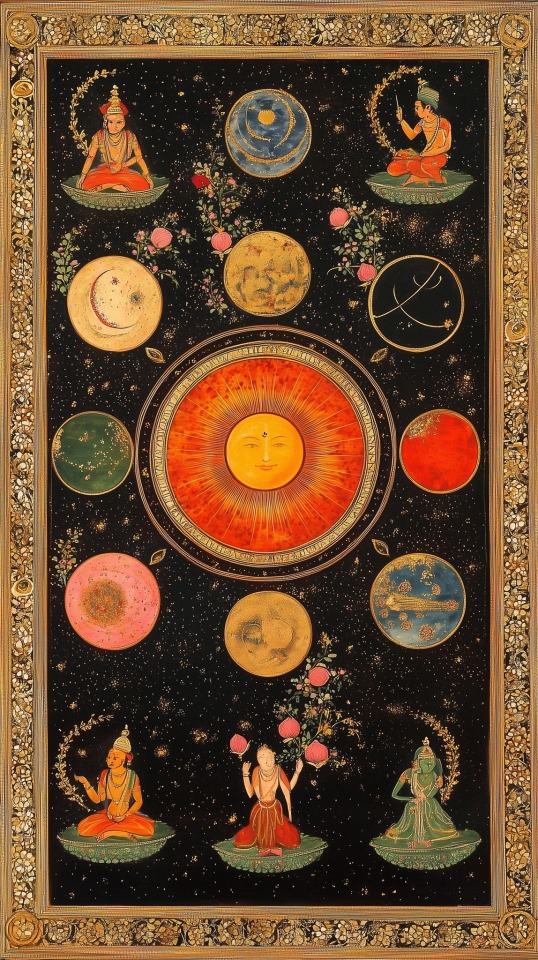
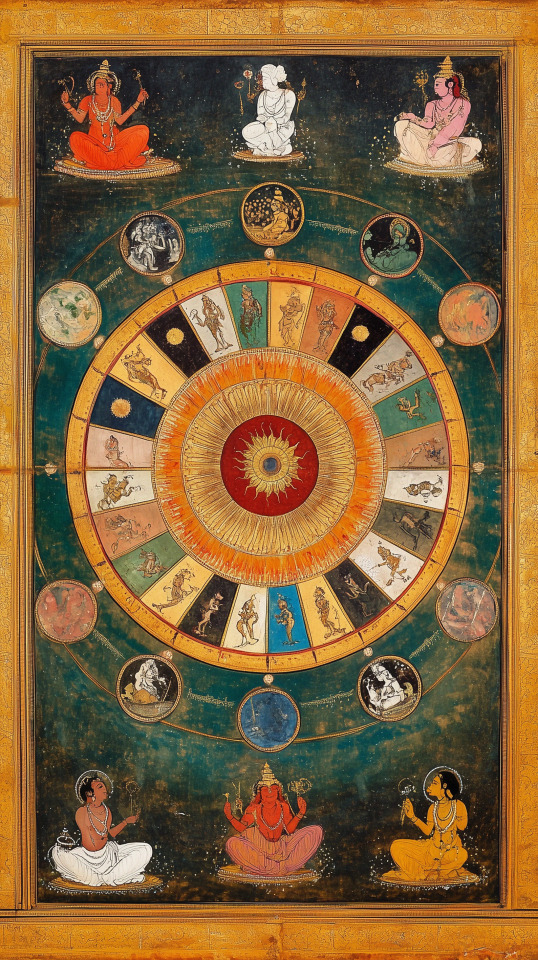
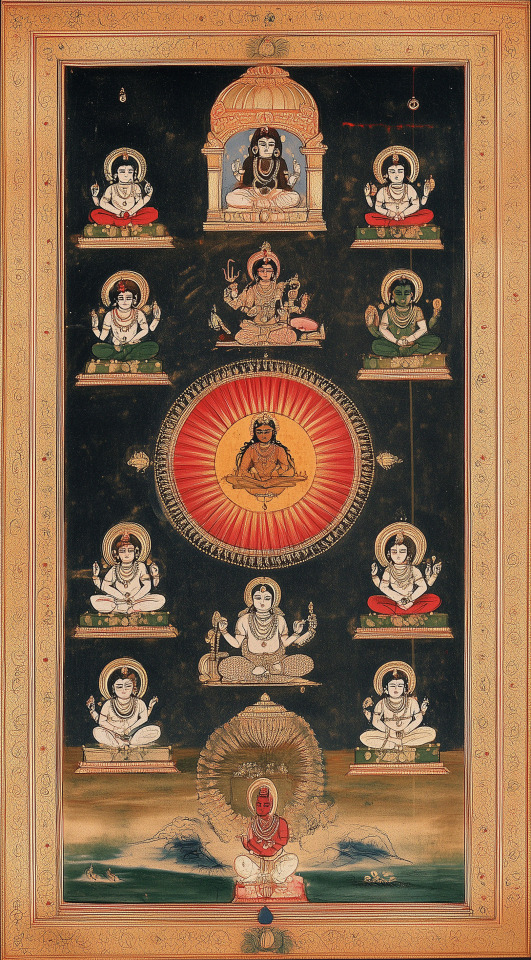
Navagrahas Talon Abraxas Navagrahas: the planets of Vedic astrology Navagrahas fall under the the Hindu Astronomy and play a major part in the Hindu astronomical sphere. The Hindu astronomy whose origin dates back to the time of Vedas is concerned with the placement of nine planets and their influence on the world and on an individual. According to the Hindu astrology, the position of the planets when a person is born determines his potential in life. The nine planets collectively are called Navagrahas. These 9 planets are worshipped by Hindus to overcome any hindrance, obstacle or bad luck. They are found mostly in all the temples and faithful believers pray to the Navagrahas before they pray to any other deity. Out of those nine planets, seven are named after the planets in the Solar System and the other two are actually demons who managed their way into this group by trickery – Rahu and Ketu. Depending upon their location in the planetary system, they are deemed either auspicious or inauspicious. While Navagrahas are found in every temple, there are some temples that are solely dedicated to them. One such temple is the Navagraha temple located in the outskirts of Ujjain. Effects of Navagrahas – Vedic Astrology In Hindu Astrology, Navagrahas affects a person’s happiness, success and all-round prosperity. The good and bad, positive and negative influences of each of these nine planets are results of factors like the specific location of the planets on the birth chart, etc. Planets possessing Sattva nature are Jupiter, Sun and Moon. Planets bearing rajas are Venus and Mercury while planets with Tamas nature are Mars, Saturn, Rahu and Ketu. These nine planets in vedic astrology are treated as deities with specific powers, nature and characteristic qualities depending on what each of these offers – positive or negative to people. 1.Sun (Surya): In the group of other planets, he is normally shown facing towards east, standing in the center. Around him are the rest of the planets facing in all different direction but not towards each other. He rides are chariot with one wheel which is pulled by seven horses symbolizing the seven colors of white light and seven days of the week. He is also known as Ravi. 2.Moon (Chandra): In the images, he is never portrayed as a complete person. Only his upper body with two hands holding a lotus each, riding a chariot pulled by 10 horses is shown. He is also known as Soma. 3.Mars (Mangala): Mangala is a Ferocious God holding with two holding weapons and 2 in mudras. His transport is a ram. 4.Mercury (Budha): Budha has four hands and rides on a chariot or Lion. Out of which, three of his hands holds a sword, a shield and a mace and the fourth hand is in a mudra. 5.Jupiter (Brihaspathi): He is the teacher of Gods and is praised in Rig Veda. He is shown sitting on a chariot pulled by 8 horses each showing one branch of knowledge. 6.Venus (Sukra): Sukra is the teacher of the Demons. He has four hands and rides on a chariot pulled by 8 horses. Three of his hands hold a staff, a rosary, a vessel of gold while the fourth hand is held in a mudra. 7.Sani (Saturn): Sani is a god who makes or breaks fortunes by his planetary position for which individuals fear him. He is shown with four hands riding on a chariot or a buffalo or even a vulture. He has three hands in which he holds an arrow, a bow and a javelin while his other hand is held in a mudra. 8.Rahu: He somewhat looks like Budha (Mercury) but both Gods differ in fundamental nature. Just like how Budha rides a white lion, he is shown riding a black lion. But just like Budha, he carries all the same weapons. 9.Ketu: In Sanskrit, Ketu means comet. It is said that he has a tail of a serpent in his body and his nature very much matched to that of a comet. In pictures, he shown riding a vulture and holding a mace.
32 notes
·
View notes